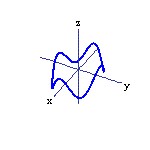Find two paths of approach from which one can conclude that the function has no limit as (x, y) approaches (0, 0).f(x, y) = 
What will be an ideal response?
Answers will vary. One possibility is Path 1: x = t, y = t ; Path 2: x = 0, y = t
You might also like to view...
Graph the curve described by the function. Use analysis to anticipate the shape of the curve before using a graphing utility.r(t) = 3 cos t i + 2 sin t j + cos 5t k, for 0 ? t ? 2?
A. 
B. 
C. 
D. 
Solve the problem.For a particular product, the revenue and cost functions are R(x) =  and C(x) = 6x + 5. Approximate the break-even point to the nearest hundredth.
and C(x) = 6x + 5. Approximate the break-even point to the nearest hundredth.
A. 0.89 B. 0.94 C. 0.85 D. 0.99
State the degree of the polynomial and whether it is a monomial, a binomial, or a trinomial.7x8y7
A. monomial, degree is 7 B. binomial, degree is 15 C. monomial, degree is 8 D. monomial, degree is 15
Suppose two dice (one green, one red) are rolled. Consider the following events. A: The red die shows 2. B: The numbers add to 6. C: At least one of the numbers is 2. D: The numbers do not add to 10. Express the given event in symbols. ? "The numbers do not add to 6." ?
A.
B.
C.
D.
E.




